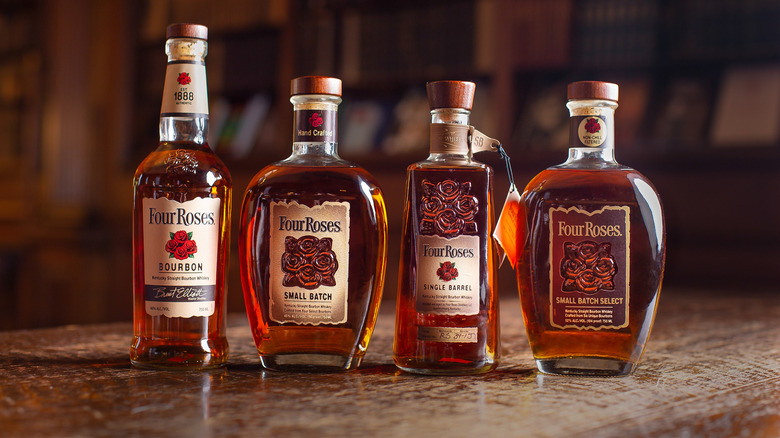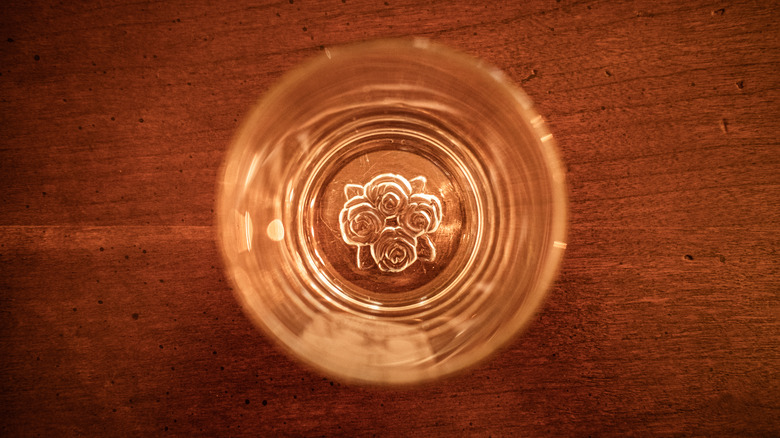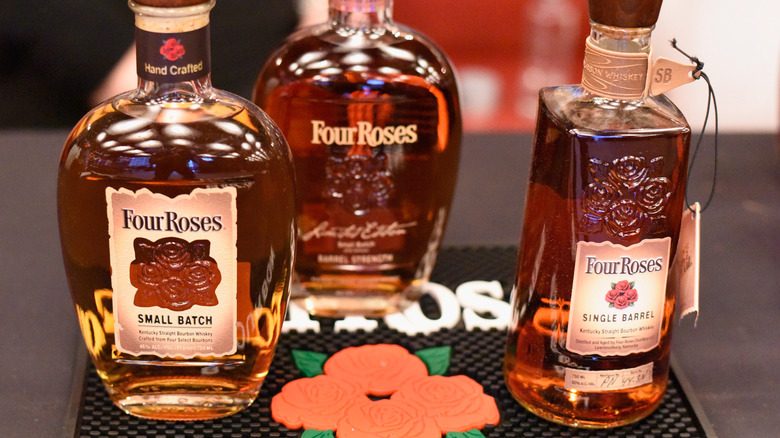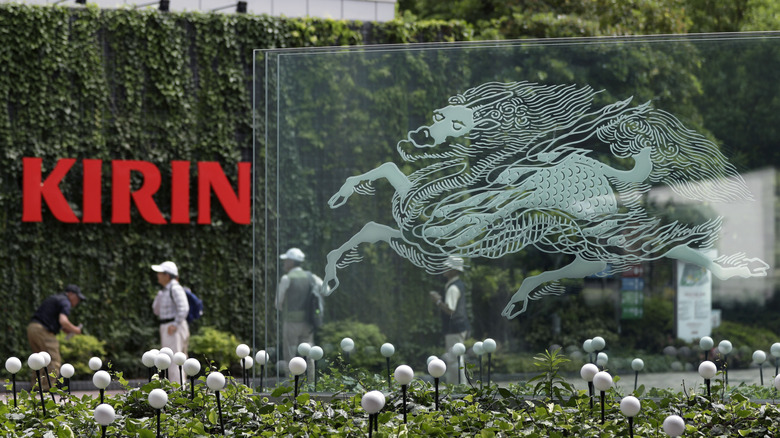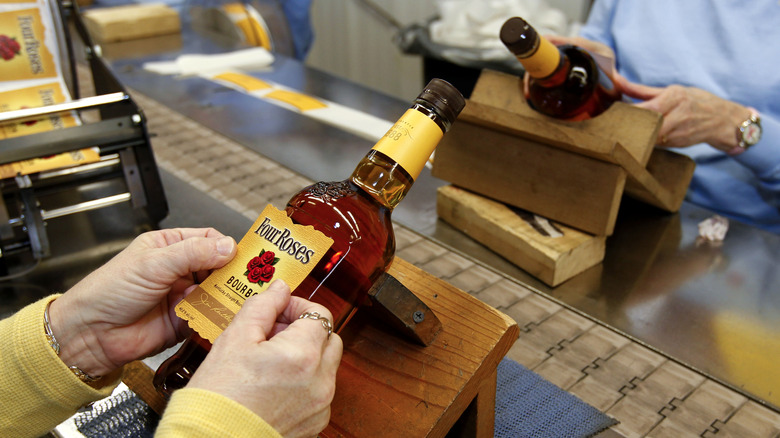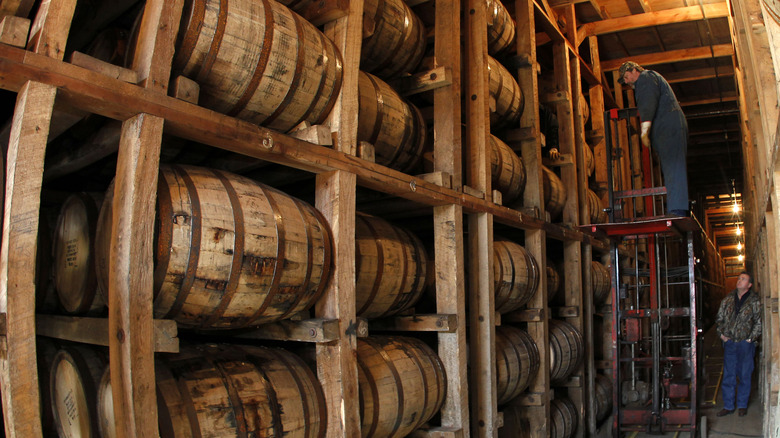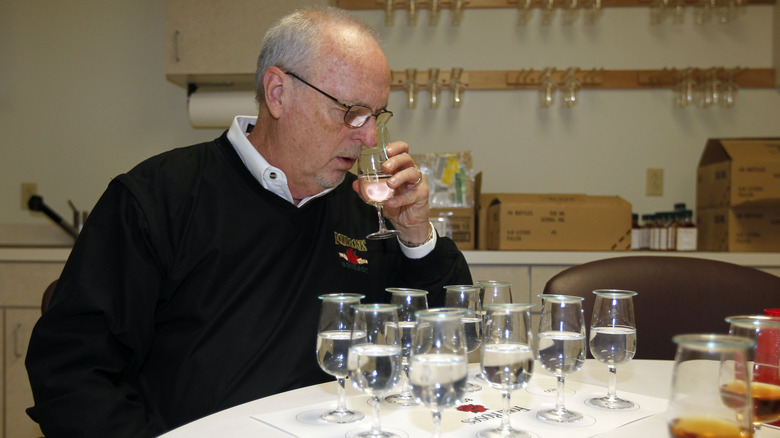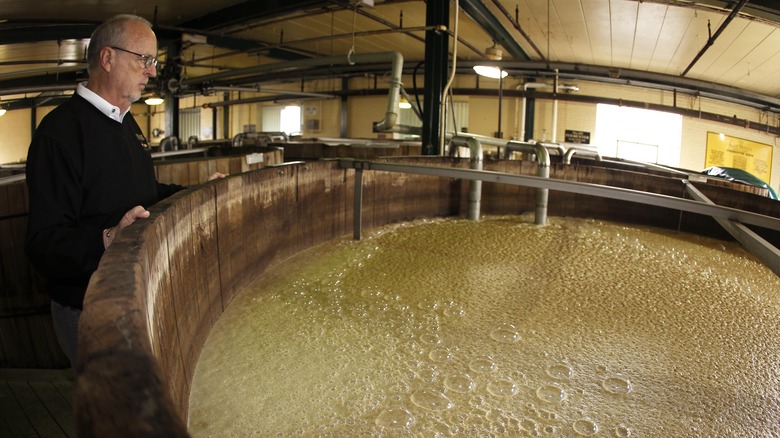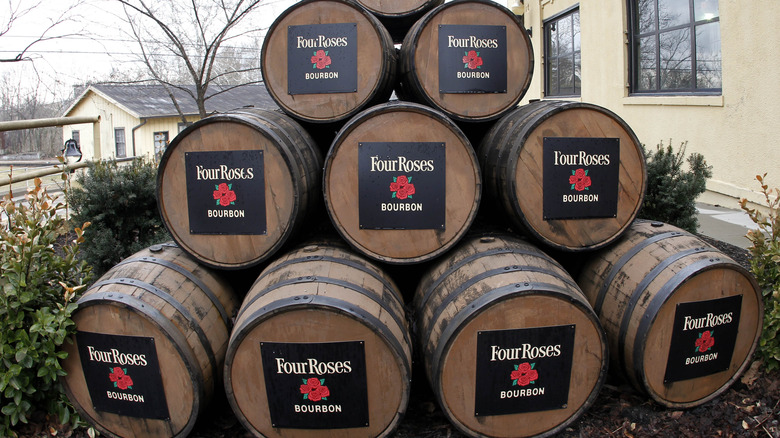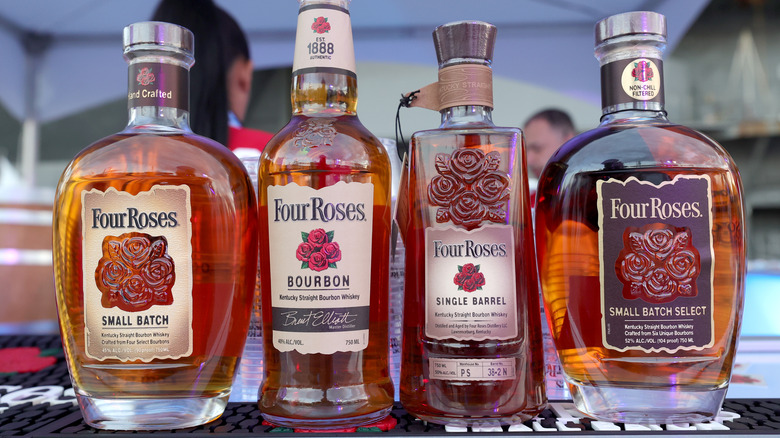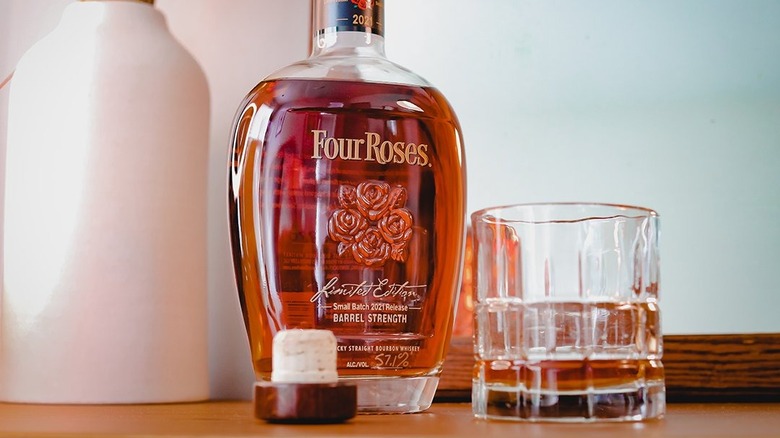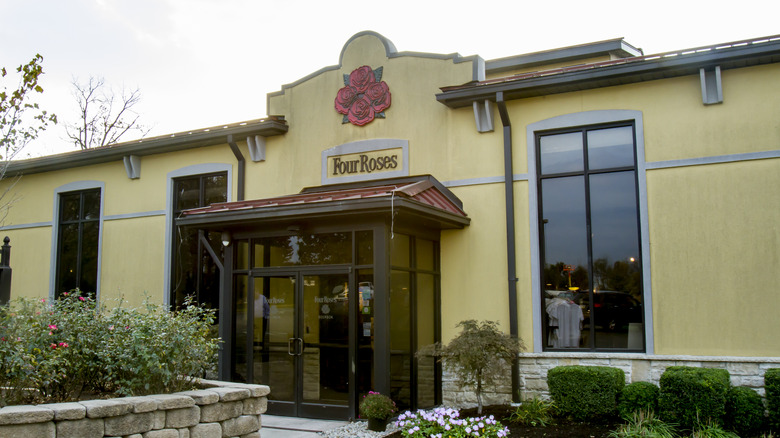12 Facts To Know About Four Roses Bourbon
Four Roses has become one of the most recognizable whiskey brands in North America. Its bourbon is now a staple of many grocery shelves, but it wasn't always that way. The distillery has a fascinating past with plenty of ups and downs over the years. This has led to a myriad of fascinating facts that are not only interesting but will make you appreciate your bottle of Four Roses even more. A part of the beauty of whiskey is the history that has gone into every drop, and not many distilleries have a better story than that of Four Roses.
In many ways, this distillery is a survivor. Not only did it get through the Great Depression and the World Wars, but it also managed to fight off prohibition and an owner who actively sabotaged the brand. This unique history has led to Four Roses doing things a little differently than many of its rivals, whether that's in how it produces its whiskey or how it's stored. These 12 facts will give you a wonderful insight into one of Kentucky's most special distilleries.
The name has a romantic history
The name "Four Roses" sounds romantic, but there is also a lovely tale behind it. The story starts with the distillery's founder, Paul Jones Jr., and his love interest. He fell head over heels in love with a Southern belle who had caught his eye. In a rather enchanting tale, he sent a heartfelt proposal to her. Instead of giving him a simple "yes," the woman said that if she agreed to the proposal, she'd wear a corsage of roses to an upcoming grand ball. Those with a creative imagination can most likely complete the rest of the story.
Of course, she arrived at the ball, showing off a beautiful corsage of four red roses. It inspired the name of this famous bourbon and gave it a story that would be the envy of many of its rivals. That is the legend, though the exact details of the story are debated. It's also a sad twist of fate that the proposal never resulted in a marriage. Paul Jones, Jr. passed away suddenly from Bright's disease in 1896, just seven years after naming his whiskey. So, the story of the naming of Four Roses may have romantic beginnings, but it ultimately became a tale of unrequited love.
It legally sold whiskey through prohibition
Prohibition was a brutal time for many breweries and distilleries, with many forced to shut down production or face the consequences. Others were luckier and managed to find ways around these laws. The sale of alcoholic beverages was banned to regular customers, though a select few distilleries were given a license to sell stock for medicinal purposes. As you may have guessed by now, Four Roses Distillery was one of the lucky ones with an exemption. The Volstead Act, which enforced Prohibition, included a provision that permitted doctors to prescribe medicinal whiskey. There is no doubt that as many people as possible were trying to take advantage of this legal loophole and receive their whiskey prescription.
Of course, the actual medicinal value of whiskey is dubious at best, but we doubt anyone who was able to get their hands on a bottle cared about that too much. At most, you could get a pint of whiskey every two weeks through your prescription, which was enough to keep sales at Four Roses ticking over. It allowed it to stay afloat when many other businesses went under. Not only that, but when Prohibition was finally repealed in 1933, Four Roses could quickly take advantage compared to other distilleries that had to start from scratch. It all adds to the rich history of Four Roses, as you can enjoy the same sip that many others would have savored during those barren years.
The sale of Four Roses Bourbon was halted in the United States
The ownership of Four Roses has changed hands a few times over the years. In 1943, it was purchased by the Canadian drinks company Seagram. Thankfully, most huge holding companies allow distilleries to continue making whiskey to their own preference, but this wasn't the case with Seagram. Despite Four Roses being the highest-selling Kentucky Straight Bourbon from the 1930s to the 1950s, the Canadian company removed Four Roses Bourbon from shelves. It started making a blended version of Four Roses instead that was mostly made with grain-neutral spirit. This was vastly inferior but was sold in a near-identical bottle. Consumers weren't fooled, and the sales of Four Roses soon plummeted as this non-bourbon imposter was rejected.
Why would a company intentionally sabotage its product? The answer is that Seagram had its own range of Canadian whiskeys, and the idea seemed to be that it could fill the void left behind by Four Roses. Thankfully, production of Four Roses Bourbon hadn't been stopped completely, as it was still sold to export markets. Seagram would eventually overplay its hand in business, and its attempts at rapid expansion in the entertainment business imploded. This left Four Roses in limbo as it was briefly sold to French company Vivendi before eventually finding a different home.
It was bought by the Kirin Brewery Company
It's easy to think of Four Roses as a quintessential American bourbon brand. After all, the whiskey is distilled, matured, and bottled in the great state of Kentucky. While all that may be true, the company has not been in American hands since it was sold to Seagram in 1943. After the fall of Seagram and a tumultuous few years during the turn of the century, it was eventually the Kirin Brewery Company that would come to the rescue. This Japanese company could have easily continued where Seagram had left off, but instead, it changed things for the better. Not only did it halt production of the low-quality blended whiskey, but it went the extra mile by buying back bottles from distributors to ensure that it no longer appeared on any shelves.
Once the old product was gone, Kirin reintroduced the much-missed Four Roses Bourbon back where it belonged. Kirin owns a vast array of brands across many industries, and it would have been easy for the Four Roses distillery to be forgotten about in the crowd. Instead, it has shown how a huge holding company should run its holdings. The glorious comeback of Four Roses was confirmed when it was named American Whisky Distiller of the Year three years in a row from 2011 to 2013 by Whisky Magazine.
10 bourbon recipes go into its signature Yellow Label
Many distilleries have a simple process: Pick a mash bill, have a standard yeast, and combine that to create a delicious whiskey. Four Roses does things a little differently. Using different mash bills and yeast strains, it ends up with 10 different bourbon recipes. It then blends all of these to make its signature Yellow Label. We say Yellow Label, but its core expression is just called Four Roses Bourbon these days and even sports a cream label instead. Regardless, every bottle of Four Roses comes from a delicate blend of these recipes to ensure consistency and quality with every sip.
Until recently, the exact taste of these recipes remained a mystery to all but those who worked at the distillery. However, in 2023, Four Roses announced the introduction of the Ten Recipe Tasting Experience. Here, you can enjoy 50-milliliter bottles of each recipe, but sadly, stocks are low, and the price is high. You'll only be able to find the set in the distillery's visitor centers and select retailers. But whether you get to enjoy these individual recipes or not, they are a testament to how Four Roses Bourbon doesn't follow the crowd and isn't afraid to do things a little differently.
It has a rare single-story warehouse
It makes sense for a huge distillery to have barrels over more than one floor. It's an obvious space-saving measure, but Four Roses isn't a fan of this way of doing things. Atmospheric conditions play a huge role in the maturation of whiskey, and having barrels over two levels can cause a difference in the taste of the bourbon. Distilleries such as Maker's Mark take the approach of rotating its barrels at different levels to ensure consistency. Four Roses has a unique solution as it keeps all its barrels in the same single-story warehouse. While this may not save on space, it does mean you don't have to worry about your whiskey having a different taste depending on where the barrel was stored.
The temperature difference between the top rack of Four Roses' single-story warehouse and the bottom maxes out at 8 degrees Fahrenheit, and therefore, any changes are minimal. One thing Four Roses does similar to other distilleries is that it also uses pre-charred new American oak barrels to give the whiskey an incredible depth of flavor. These barrels are then stenciled for a few reasons, one of them being to keep track of which of the recipes was used. After at least five years of sitting in its single-story warehouse, the barrels are ready to be emptied, and the whiskey inside is ready to be enjoyed.
Four Roses use five proprietary yeast strains
Yeast plays a large role in all of Four Roses 10 recipes. In fact, it uses five strains, and each impacts the whiskey. These strains hark back to when Seagram owned the brand. For its blended whiskey, Four Roses was made from whiskey distilled at several distilleries. It had little control over the process, leading to the low-quality product that was served up for many years. It was Four Roses by name, but in reality, very little of the whiskey was from its distillery. Once Kirin Brewing Company took over the company, it had to decide how to move forward.
Instead of discarding the yeast strains used in those distilleries, Kirin kept them. The difference now, of course, is that Four Roses uses all these five yeast strains exclusively at its distillery with no outside input. As with any distillery, this yeast is used for fermentation, without which alcohol couldn't be produced. The fermentation of sugars into alcohol is not just an indispensable part of the process, but this yeast will also impart its unique flavors and aromas to the whiskey. With five strains used, Four Roses can create a distinct and high-quality spirit that would be impossible to replicate at any other distillery.
Four Roses uses two distinct mash bills
Another factor that goes into the 10 different recipes is the two mash bills. You'd be forgiven for thinking that most distilleries have several mash bills for whiskey. After all, this would allow brands to create a greater range of products with different taste profiles. In reality, we see the opposite. Most distilleries will have one mash bill that gives all its whiskies a signature taste. Some have a high rye content, while others will specialize in using wheat instead. When you add the 51% minimum corn and malted barely into the mix, it's easy for a distillery to create its own special mash. Again, Four Roses likes to do things a little differently.
Due to experimentation over the years, these two mashes are called "Mash Bill B" and "Mash Bill E." The "B" mash bill contains 60% corn, 35% rye, and 5% barley. The "E" mash bill is 75% corn, 20% rye, and 5% barley. Each recipe is given a four-letter code, such as OBSV, with the mash bills (E or B) accounting for the second letter.
The first letter, "O," designates it as from Four Roses Distillery, and the "S" stands for "Straight Distillation". The fourth letter is the yeast stain used. For example, OESV means Mash Bill E was used, as was the V yeast strain, which gives a taste of delicate fruit. Once you become a Four Roses expert, you'll come to understand your OBSK from your OBSQ.
Four Roses is committed to responsible production
Never has it been more important for companies to make products responsibly. Many distilleries are putting in extra effort to be more environmentally friendly, and Four Roses is at the forefront. The first aspect of that is using locally sourced ingredients, which not only helps the wider community but reduces its environmental impact. Four Roses is aiming to further reduce its ecological impact along with proactively complying with all environmental regulations.
The benefit to the community doesn't just stop at its environmental practices. It supports a range of community projects and supports many charities throughout Kentucky. One such community project is the Salt River Clean Up Day, which has been held in September for five years running. This event helps to improve the quality of the water, which is vital for not only the environment but also the quality of Four Roses bourbon. It's clear that the distillery knows its responsibility to the local community and those who enjoy its whiskey.
It doesn't like age statements
Age statements are a funny thing in the whiskey world. A wide range of factors affect the maturation of a whiskey. Barrels can mature at different rates, meaning age statements can paint an inaccurate picture of the whiskey inside. On the other hand, it's true that whiskey aged for longer periods generally does have more depth and complexity. Due to this, many whiskey buyers will automatically equate an aged whiskey with quality, but this isn't always the case. It's due to these reasons that a Four Roses age statement is not something you'll see on its whiskey.
Four Roses' own Master Distiller has told Vinepair how he prefers younger, more vibrant whiskeys, which allows the distillery to focus on taste rather than worrying about meeting an arbitrary age number. It's important to appreciate that age doesn't automatically equate to a great whiskey. Despite this, Four Roses does understand that bourbon needs to be matured for a long time before it can reach the desired quality. Its flagship Four Roses Bourbon has matured for at least five years, with its more expensive expressions being left for even longer. Despite this respectably long maturation process, Four Roses doesn't feel the need to tell the world exactly how old the whiskey is.
It has created some exceptional limited editions
While Four Roses may not like age statements, it loves a limited edition. Along with its four core expressions, it usually releases small batch whiskeys each year. This is the chance to experiment with its various recipes to create bourbons with a different taste profile than a standard release. The only issue with these small-batch offerings is they sell out quickly and aren't cheap. The 2023 version celebrated its 135th anniversary and used just three of its 10 recipes. It led to a bourbon that beautifully combined the classic bourbon notes of oak, vanilla, and spice, along with more subtle hints of honey, berries, and pear.
Of the many Four Roses Bourbon bottles out there, its greatest limited-edition release is perhaps the 2019 version. Only 13,440 bottles were released, and they are getting increasingly rarer and more expensive. This was created using four different recipes but had all been matured for at least 11 years, with its OBSV being left in the barrel for 21 years. It led to a bourbon with incredible depth and a wide range of notes on the palate, including fruits, cocoa, nuts, and toffee. It's unlikely you'll be able to get your hands on a bottle now unless you have money to burn. In the meantime, you can patiently wait for the next limited release or simply enjoy standard expressions.
Four Roses offer guided distillery tours
The esteemed Four Roses distillery offers a fantastic, guided tour. You'll see the craftsmanship firsthand as Four Roses showcases the art of distillation. Visitors can also hear much of the rich history as they tour around the distillery in Lawrenceburg. Plus, you can also visit the Cox's Creek Warehouse and Bottling Facility, which is 50 miles away but can be seen using the same single ticket. The only stipulation is that you have 60 days to complete the touring experience.
At the main distillery, you'll see the inner workings, from the cookers to the towering cypress fermenters. The tour continues through the distillery's stills, featuring both column stills and pot still doublers. Of course, a distillery tour isn't complete without a tasting, and you'll get to savor a fine selection of its bourbons. The warehouse gives you a different look at whiskey production, including the bottling and barrel dumping/filling. It's well worth the visit to expand your whiskey knowledge and become a Four Rose aficionado. As we've seen here, Four Roses is a great distillery with a fascinating history. If you can't visit it in Kentucky, you'll have to settle for sampling its world-renowned bourbon from the comfort of your home.
